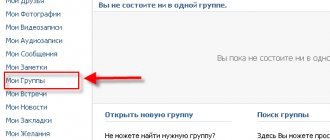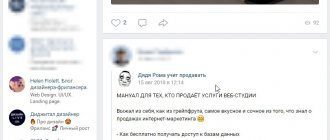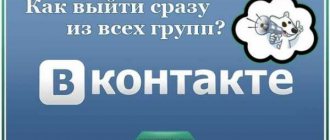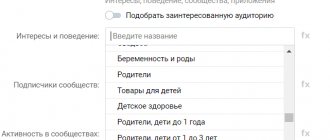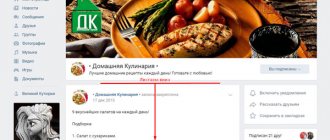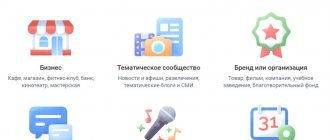Rating 5.00 [5 Vote(s)]
Details Category: Social networks Author: Administrator
In one of the materials posted on our website, you learned about how to buy a VKontakte group and what you should pay attention to when purchasing it - How to buy a VKontakte group. In that article, we gave simplified indicators for calculating the cost of a group. Today I would like to talk in more detail about this topic. In this article we will try to tell you how to calculate the cost of a VKontakte group.
Parameters by which the VKontakte group is evaluated
There are many parameters by which you need to evaluate a group before purchasing it. Let's look at the most important of them.
Group topic
A lot depends on the theme of the group. For example, a group dedicated to humor will cost less than a group dedicated to business. Below are examples.
Number of participants in the group
Everything is simple here. The more participants in the group, the better.
Number of dogs in the group
In a normal group, the number of dogs (inactive accounts) should be within 5-10%.
Group income for the last 10 months
Naturally, the higher this indicator, the better. However, it is often very difficult to get real income data from the seller, because many people like to pretend.
Average daily number of unique visitors for 30 days
For a good group, this figure will be about 40-70% of the total number of participants.
Average number of likes
According to statistics, 10-20% of group users rate posts by clicking on the “Like” button.
Average number of reposts
According to statistics, about 1-3% of group members share posts on their page.
Creation and basic settings
Physically, you can actually create a community for yourself in 2 minutes, or even less. To do this, just go to the “Groups” section of the menu, click on the “Create a community” button, select the format and topic, enter the name and that’s it, you’re done. The community actually exists, the mission is accomplished. But we move on. For this is not the creation of a community, but the creation of a filly literacy. With such horses you won’t go far and certainly won’t get clients.
In general, if you create a community for yourself, you can immediately enter both a name and a description for the “Information” section. But we will postpone work on content until later, and in this section we will tell you how we make basic settings.
- We change the digital URL to a beautiful, memorable address that can be written on business cards and is pleasant to the ear.
- Let's check the topics and categories again. Please note that this must be done immediately. In the future, a sudden change in topic may lead to blocking of the community.
- We add a link to the company’s website, indicate the location (if this is our group).
- In a special tab, select the necessary settings by section: which will be displayed in your group (we are studying the client’s business), which will be open to users (based on the strategy for working with the community), and which should generally be closed and given access only to managers.
- Here we insist on the “Products” section - in case you decide to make a seller out of the group. In our case, this is done if the community has a section with goods (agreed with the client, based on the strategy for working with the community). The basic rate includes registration of 1-3 products as an example.
- Select the main and secondary blocks. For example, if you want discussions to be at the very top under the description, this section should be placed in the main block. This is also important when working with an application widget. But here there can be a lot of options for the development of events, so all questions regarding filling out this block are resolved individually, based on the objectives of the project.
- We make settings for obscene language and special words that cannot be mentioned in your community, for example, the name of competitors.
- We add links to the site and other resources that are important for the company and users. You can make a link here to individual sections in the community menu (delivery, payment - if you have a commercial community and this is very important information that should be emphasized) or website pages, services with reviews, etc.
- Messages. We don’t just connect them, we create a welcome message that will be received by users who decide to send you a letter in the community. Well, we always recommend that the client add a link with community messages to his left menu so as not to miss a question and answer as quickly as possible. As for the settings for the “Online Community”, we do not make them and do not recommend implementing them, since you need to respond promptly, and this is not always possible. But you can activate the function yourself at any time.
Other settings are not included in the price. Application installation work is agreed upon and paid for separately. Setting up and launching one application from the VKontakte application list costs from 1000 rubles, depending on the complexity of the work.
A simple formula for calculating the cost of a group
To begin with, we would like to offer you a simplified formula for calculating the cost of a group. We will include only a few parameters in it. The formula looks like this. All odds are listed at the bottom of the article.
Where
S – group cost
P – number of subscribers
Kt – group theme coefficient
Kc – coefficient of pawls in the group
If we know the exact income of the group for the last 10 months, then it is worth using a slightly modified formula.
Where
D – group income for 10 months
Working with content
In this section we talk about how we work with content when creating a community.
Compiling a semantic core for the community
When creating a community, we always optimize for the large Internet and internal search. Compiling a semantic core is an integral part of this process. Of course, there is no way to add +500 words, but optimizing for 5-10 queries is quite possible. Especially if you consider the nesting of keys.
So, taking into account the frequency according to Yandex statistics, we collect a semantic core for each new community. At the same time, we analyze the client’s business and take into account the goals facing the promotion of the community. The result is a table of key queries that need to be used when working with the community (photo descriptions, answers in discussions, posts, etc.)
When choosing words, pay attention to the following points:
- Key query: it is better to indicate the word being checked in quotation marks, then we will get pure results for it and will be able to assess what else people are looking for with this query. By the way, here is a cheat sheet for working with the service.
- Region: of course, we are interested in the region in which the company operates. This could be all of Russia or a separate city. This way you will understand the approximate demand in the desired area.
- Actually the number of requests for the key you are interested in.
- Other, more detailed options are also requested for this word, and there are quite a lot of them. This is good. Such requests, as a rule, help with drawing up a content plan and expanding the semantic core.
- Similar queries. They can also be used to expand language and find topics for content.
Of course, these are not pure statistics on social media keywords. It is more of a guide because the audience is duplicated and therefore that is how they are searching for your business.
For social networks, unlike a website, you should look at the most common request. Because most likely, if they are looking for “plastic windows” in an internal search, then they need a company to work with them, and not an article about windows, etc.
If you want to see the statistics of a key query specifically for VKontakte, you can use the target hunter service: it allows you to analyze the dynamics of the query (mentions on social networks) for a given word by year and by month. You will understand whether anything is written about it at all or not.
We only double check as part of strategy development. As part of creating a community, we look at statistics on Yandex.Wordstat, analyze the results of internal searches, and in especially difficult cases, when there is no data or it’s difficult to choose, we look at statistics on third-party services.
Title development
Selecting a name begins with determining positioning. There are 3 types of positioning: by brand (if the company is well-known or the brand needs to be promoted), by product (when the brand is not very important to us, but the product is worth promoting. For example, flower delivery: it doesn’t always matter which company to order from, but this service is quite popular), according to interests (here we are actually talking only about the interests of subscribers and do not directly sell anything). The choice of positioning is based on the goals that the community faces.
This is what a sample template for each name looks like:
- By brand: Raduga is a global ice cream manufacturer.
- For the product “Ice cream from all over the world in the Rainbow shopping center.”
- Interested in “Rainbow Ice Cream Lovers Club”.
Do you feel it? Based on the name, the content should be special for each community.
How do we choose?
- Let's look at the goals. If you need to sell, then option 1 or 2, if you need to inform, option 1 or 3.
- We look at competitors. And here the analysis of competitors by topic begins.
Competitor analysis to choose a community name
First, we gather competitors:
- We ask the client who his competitors are (list of sites or communities).
- In internal search, we collect communities using previously defined keywords - up to 3-5 for each community.
- We collect communities in the search that appear in high positions based on keywords (TOP 10).
We analyze the collected communities.
- We determine positioning for the collected communities. We look at the ratio of options and select the most optimal one. You can choose the most popular option, and then give users something special that your competitors don’t yet have, or, for example, simply become better with the same content if competition is low. Or, conversely, choose the option that has the least number of competitors (provided that it suits our work format).
- We determine the competition using the collected keywords. How many users in the communities are in top positions, will it be difficult to get to first place, is the number low.
- We check for bots in communities. This will help determine the number to target at the start. Real headcount for the required key queries. She will show you which word to use and how to work.
- We determine the principle of ranking in search results for the desired query: are there any jumps in number in the TOP or is there a decrease in numbers exactly.
- We check for dilutions (whether there are extraneous words in the selected keywords for the title or not). For example, a community in the TOP may be called “Plastic Windows ,” or “Company for the installation of plastic and wooden . ” The second option is to dilute the key. I note that the pure occurrence of a key is one of the ranking factors. Those. other things being equal, preference will be given to the community without dilution.
Having collected this statistics, we determine what strategy the name will be based on, and in the report we offer the client, as a rule, 2-3 options with a description of the reasons for choosing each of them. The final decision, of course, remains with the client. But we always say the reasons and consequences that will await a certain choice.
It is important that when you create a name for the community yourself, please note that there is a principle here (for search): the fewer words, the greater the weight of each of them. Much the same as for the Title tag.
Well, one more thing: if you are changing the name now, keep in mind that you will experience a temporary decline in positions. This is fine. Over time, depending on your activity and the activity of your competitors, your position will recover and may even improve. Of course, if you work with social networks.
Community status
The name has been chosen, now you can think about filling out the community status. We do not recommend duplicating information here that you have already written in the title (on the cover). They often write something like this:
The status should expand the information from the title and complement it. What nuances do we pay attention to when filling out this block of information?
- Indication of geolocation (city, region in which it operates). For example, if you do not want to overload the name with an indication of the region.
- Promotions that encourage joining the community (10% discount for friends, details in the menu).
- USP of your company: delivery within Moscow time in 10 minutes, when ordering 3 or more pieces, a surprise gift worth 1000 rubles.
- Clarifications on brand, product, company. For example, you indicated in the title that you have an online store of bed linen, and in the status you can clarify the areas you deal with: blankets, pillows and sheets made of camel hair.
- Special conditions for the store: retail sales only, opening on January 15, closed on holidays, etc.
When creating a community, we proceed from the purposes for which the group will be used and select the status.
Please note that ideally, a key query from the semantic core should be inserted into the status, since the status is taken into account during optimization. But if you can’t do it organically, it’s better to focus on people than robots.
Description
Information is a section that is located immediately below the name and status. It is visible if there is no pinned post in the community. If there is a pinned post, then this section goes into the second tab.
Here your task is to talk about the company and the community so that users want to join and take the targeted action.
In order to write text for the “Information” section, we analyze the client’s website and business. We study how the company is useful, what conditions it offers, why users need to subscribe to news / join the community.
Don’t forget that the text should end with a call to action: write to us, place an order in our online store, etc.
One of the common mistakes that we encounter during analysis is the story of how cool and wonderful the company is. In fact, it is important to say the same things, but only from a position of benefit for the client.
So, in this section the following tasks are solved:
- More detailed information about the company is provided.
- Enter numbers and facts that remove the user’s objections and confirm your words.
- The reasons why the user needs to join the community are indicated.
- There is a CTA to push the user to take a targeted action.
It is important to remember that the text for this community section must be unique and optimized for the keywords that you included in the semantic core for social networks. To structure your text, you can arrange it in a list (numbered, under bullets, or using emoji icons). We put all the links here with tags (using them you will track the statistics of transitions and achievement of goals on the site) for social networks and shorten them through a special service.
We usually write text of 500-1000 characters with spaces. We optimize it for 1-3 key queries from the strategic language. We check for uniqueness (90-100%) through the text.ru service, as well as for nausea through advego.
By the way, such text can be ordered separately from our copywriters. The cost will be 1950 rubles. for 1000 characters.
Filling out the discussion section
Yes, as part of creating a community, we also fill out this section. Discussions are very well indexed by the Google search engine. Therefore, it is also important to work on text optimization here. Moreover, it is important to include keywords from the collected semantic core in the title of the discussion, preferably without dilution, as well as in the text with a description. As part of the service, we create 1-2 discussions for the company:
- We select a topic for discussion. As a rule, these are reviews about the company. They are always important, especially on social networks. We need to let clients speak.
- We compose the description text with keywords from the semantic core.
- Add to the community.
In addition to these works, when transferring rights to a community, we always tell you how to correctly work with keywords in the community. What elements to optimize, what to pay special attention to.
In general, that seems to be it, but who wants to join an empty community. Nobody, that's right. Therefore, we are adding 5 publications to the community. Next, I’ll tell you exactly how we select topics and compile them.
Community audience
Let's say we bought a community. We have a certain number of people who are united by a common interest (or interests).
In the part about buying VKontakte groups it was said that Mikhail was changing the theme of the community. It is dangerous to radically change the topic. All people will leave. Imagine that you signed up for a swimming pool, and then it turned out to be a copywriting course. I think you will leave as soon as possible. Same with communities. You can try to turn the community's interest. For example, a community dedicated to Japanese cars in the direction of a specific model. It was “Japanese cars”, it became “Japanese cars. Lexus." Conclusion: if you buy a group with the goal of changing the topic, then you should take into account the outflow of participants. The percentage of churn depends on how “cool” you change the topic.
Another article with an interesting opinion belongs to Tömme Mainas (see “Why I don’t believe in viral marketing on VKontakte”). True, we are not talking about viral marketing at all (see next article “Viral marketing”). The point is that communities (either newly created or purchased) have a bad audience. An example is given where users invite their friends who do not fit the target audience of the community. At the same time, the customer thinks (or is told) that he has a loyal audience, although this is not the case.
There is a comment by Pavel Durov, who seems to disagree with Temma Mainas:
| Viral marketing in groups works because the name of the group is reflected in the news. In addition, it remains forever on the profile pages of those who joined. This is not very effective on its own, since there are restrictions on invitations to groups. But for companies there is a special group service, when restrictions are lifted, the group is displayed on the first page and a mass invitation is possible. — Pavel Durov, General Director of VKontakte LLC |
If you read the article, you will understand that Temma and Pavel are talking about slightly different things. My opinion is closer to Durov’s. Besides, I don’t completely agree with Temma.
When creating communities through me, an agreement is concluded, which clearly states that the community must have, for example, 10,000 people by a certain number who meet the following criteria:
- age: from 17 to 23 at the time of completion of work;
- place of residence: Moscow and Moscow region;
- a person must necessarily study full-time at a Moscow university;
- a person must be interested in extreme sports and (or) recreation.
This way you can target your audience quite strongly. If some part of the users does not meet the specified criteria, then either the missing number of users are invited, or the money for “defective” users is returned. Usually 3-5% of “defects” are allowed.
Tömma is right that if you choose bad contractors and do not document the relationship, the effect will be appropriate. Approximately the same as described by him.
Online services for collecting statistics on content on social networks
To collect statistics on the effectiveness of content on social networks, it is convenient to use services: often it is enough to connect work accounts and upload the necessary data. Often they allow you to track indicators in real time and save data in table format for subsequent layout into reports. Let's look at a few of the most popular ones.
Datafan The service works as a connector for Google Data Studio, MS Power BI and MS Excel, which analyzes advertising offices and accounts on Facebook, Instagram, Odnoklassniki and VKontakte. The reports are dynamic, in a dashboard format (all data on one page), and the price per month starts from 200 rubles (one of the lowest for similar services).
Analytics of posts in Datafan for the VKontakte community
Datafan is good with a large number of templates and flexible settings: this service is tailored for reports, so working with it is simple and convenient. For example, there is a content report template that clearly shows the dynamics of reach, impressions and engagement for any selected date. You can independently customize all the columns, graphs and charts you need.
Popsters A service for analyzing competitors' posts and pages on social networks (including TikTok, YouTube, Pinterest and others). It can evaluate the popularity of a post: you can find out which posts attract an audience and which ones do not. Data can be sorted by publication time, formats, hashtags, text volume in order to compare between your own indicators or those of competitors.
Popsters content statistics
You can upload data in XLSX, PDF, PNG, JPG, CSV formats or in PPTX for visual editing. The trial period lasts 7 days and after that the price will be 399 rubles per month.
LiveDune The service allows you to evaluate the quality of posts a few hours after their release. You can find out the rate of likes relative to other posts, compare coverage, number of comments and engagement to the number of posts or subscribers. Livedune can also analyze the length of posts, mentions in other accounts (on Facebook), audience and the effectiveness of advertising campaigns.
Content analysis of posts in LiveDune
The service is well tailored to work with Instagram: it probably has the most complete analytics for Stories. Reports can be uploaded to Excel, PDF, Power Point. You can compare competitors' accounts. The monthly price starts at 300 rubles.
JagaJam Service provides a large number of services for brand analytics. One of them is an SMM report on the page of any brand on VKontakte, Facebook, Instagram, Twitter, Odnoklassniki and YouTube. In this report you will find content metrics: number of posts, engagement, activity in comments.
Example slide with content statistics from JagaJam
The download is available in PPT, PDF and Excel format for creating your own tables.
Feature of the service: you do not have direct access to your personal account, the report is compiled upon request (from 2 hours after payment) and sent by mail. The price tag starts from 990 rubles for a monthly report. The more extensive the analytics for the period, the higher the price.
Guarantee
In order to buy a group in Odnoklassniki, safely use the transaction guarantor.
I’ve seen quite a few friends of scammers who cheat and don’t hand over the group, I certainly haven’t encountered this myself, but I’ve seen dozens of people on the forums who wrote their complaints about being scammed. And therefore, use a transaction guarantor and only verified guarantors who have good reviews on third-party forums, and garant.pro is considered the best.
The main methods used by scammers are to recommend their own guarantor, created by them, as a guarantor and, of course, do not transfer money.

